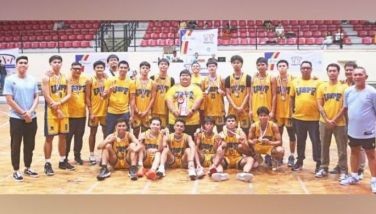Gov’t gives green light for $1.2-B MRT-7 intermodal transport system
August 14, 2004 | 12:00am
The proponents of the $1.2-billion Metro Rail Transit (MRT) 7 intermodal transport system expect to start the project by early next year after the National Economic and Development Authority (NEDA) approved the project on first pass, sources told The STAR.
NEDA’s Investment Coordination Council (ICC) gave the green light for the project after its proponents manifested their readiness to fully comply with the ICC’s requirements.
The proposal will then be subject before the end of the year to the so-called Swiss challenge, wherein other parties will be allowed to match the unsolicited offer of MRT 7’s proponents which the latter will again be allowed to match.
"But we do not expect any challenge to be made to our offer because this project is something that will be difficult to match," the proponents told The STAR.
The proponents, led by Universal LRT Corp., are putting in $300 million in equity investments and will borrow another $900 million for the mass transit system.
Another $500 million will likewise be secured for the real estate component of the project. The MRT-7 group also include SM Capital, BDO Capital, PentaCapital, the Go family, International Finance Corp., and other multilateral agencies.
Transportation and Communications Secretary Leandro Mendoza said they are in continuous discussions with the proponents to further reduce the government’s exposure in the project and to work out the annexes to the proposed concession agreement.
"We hope to submit the results of our discussions to the NEDA-ICC for its consideration for eventual second pass approval at the earliest possible time," Mendoza said in a letter to NEDA Director General and Socioeconomic Planning Secretary Romulo Neri.
The project proponents said they have hurdled most of the major requirements to pave the way for MRT-7’s implementation. These include a legal opinion from the Department of Justice determining that the proposed concession agreement does not contain any violation of the Build-Operate-Transfer (BOT) Law with respect to government guarantee or subsidy.
The BOT project, whose railway line will run from Marilao in Bulacan and Caloocan City to SM North Edsa, will involve the construction of a 22-kilometer railway transit system, a 17-km eight-lane asphalt road, 13 elevated stations and one underground station.
Once completed, MRT-7 will have an initial capacity of 650,000 passengers per day, which could be expanded to 850,000.
Universal LRT Corp. is led by EL International Holdings, a member of the EL Group of Companies of Hong Kong. The other consortium members include the Yuchengco-owned EEI Corp., TCGI Engineers, Tyco subsidiary Eart Tech and Alstom Phils.
US-based Tyco is the biggest manufacturer of electrical and electronic components while French firm Alstom is an infrastructure giant.
Universal LRT and Alstom are the same group behind LRT-1 on Rizal and Taft avenues and MRT-3 along EDSA.
MRT-7 will begin its route from Marilao, passing through the La Mesa Dam reservoir, Fairview, Batasan complex, University of the Philippines in Diliman, Philcoa and EDSA-Quezon Avenue.
In a presentation made before President Arroyo yesterday, Univeral LRT chairman and former Finance Secretary Roberto de Ocampo said government’s share in net revenues will run to as high as 70 percent at no cost to government. It will be privately financed and will not entail any government subsidy nor direct government guarantees.
The project is considered the single biggest investment during the Arroyo administration.
When completed, MRT-7 will boost the viability of LRT-1 and MRT-3 to which the new line will be connected. The proponents said MRT-7 will complete Metro Manila’s rail loop and, eventually, transfer hundreds of thousands of commuters to MRT-3.
Aside from a railway transit system, MRT-7 will also consist of a 17-km, four-lane asphalt private road; a 20-hectare "intermodal" bus station and train depot; a 20.9-km elevated light rail transit from Tala in Caloocan to North Avenue and EDSA in Quezon City; a 4.8-km. spur line connection to LRT-2 on Katipunan Road; and an integrated joint station with MRT-3’s Phase 2.
MRT-7 also aims to reduce the number of provincial buses clogging Metro Manila’s roads. The project proponents said MRT-7 would halve travel time from northern Metro Manila to Quezon City.
The main highlight of the MRT-7 project, however, is the creation of a new city in Bulacan over a period of 25 years, wherein government will get a 20 percent share in the land.
The proponents intend to develop a 195-hectare property partly serving as MRT-7’s depot into a mixed-use residential and commercial project.
Overall, the property development company will be investing a total of P2.6 billion for the residential-commercial projects, inclusive of land development within three years.
Aside from de Ocampo, other prominent people behind the project include retail giant Henry Sy; Eli Levin; Vicente de Villa; George Uy; Samson Lazo; Walter Mergelsberg; Claudio Altura; Jovencio Cinco; Romeo Bernardo; and Peter Wallace.
NEDA’s Investment Coordination Council (ICC) gave the green light for the project after its proponents manifested their readiness to fully comply with the ICC’s requirements.
The proposal will then be subject before the end of the year to the so-called Swiss challenge, wherein other parties will be allowed to match the unsolicited offer of MRT 7’s proponents which the latter will again be allowed to match.
"But we do not expect any challenge to be made to our offer because this project is something that will be difficult to match," the proponents told The STAR.
The proponents, led by Universal LRT Corp., are putting in $300 million in equity investments and will borrow another $900 million for the mass transit system.
Another $500 million will likewise be secured for the real estate component of the project. The MRT-7 group also include SM Capital, BDO Capital, PentaCapital, the Go family, International Finance Corp., and other multilateral agencies.
Transportation and Communications Secretary Leandro Mendoza said they are in continuous discussions with the proponents to further reduce the government’s exposure in the project and to work out the annexes to the proposed concession agreement.
"We hope to submit the results of our discussions to the NEDA-ICC for its consideration for eventual second pass approval at the earliest possible time," Mendoza said in a letter to NEDA Director General and Socioeconomic Planning Secretary Romulo Neri.
The project proponents said they have hurdled most of the major requirements to pave the way for MRT-7’s implementation. These include a legal opinion from the Department of Justice determining that the proposed concession agreement does not contain any violation of the Build-Operate-Transfer (BOT) Law with respect to government guarantee or subsidy.
The BOT project, whose railway line will run from Marilao in Bulacan and Caloocan City to SM North Edsa, will involve the construction of a 22-kilometer railway transit system, a 17-km eight-lane asphalt road, 13 elevated stations and one underground station.
Once completed, MRT-7 will have an initial capacity of 650,000 passengers per day, which could be expanded to 850,000.
Universal LRT Corp. is led by EL International Holdings, a member of the EL Group of Companies of Hong Kong. The other consortium members include the Yuchengco-owned EEI Corp., TCGI Engineers, Tyco subsidiary Eart Tech and Alstom Phils.
US-based Tyco is the biggest manufacturer of electrical and electronic components while French firm Alstom is an infrastructure giant.
Universal LRT and Alstom are the same group behind LRT-1 on Rizal and Taft avenues and MRT-3 along EDSA.
MRT-7 will begin its route from Marilao, passing through the La Mesa Dam reservoir, Fairview, Batasan complex, University of the Philippines in Diliman, Philcoa and EDSA-Quezon Avenue.
In a presentation made before President Arroyo yesterday, Univeral LRT chairman and former Finance Secretary Roberto de Ocampo said government’s share in net revenues will run to as high as 70 percent at no cost to government. It will be privately financed and will not entail any government subsidy nor direct government guarantees.
The project is considered the single biggest investment during the Arroyo administration.
When completed, MRT-7 will boost the viability of LRT-1 and MRT-3 to which the new line will be connected. The proponents said MRT-7 will complete Metro Manila’s rail loop and, eventually, transfer hundreds of thousands of commuters to MRT-3.
Aside from a railway transit system, MRT-7 will also consist of a 17-km, four-lane asphalt private road; a 20-hectare "intermodal" bus station and train depot; a 20.9-km elevated light rail transit from Tala in Caloocan to North Avenue and EDSA in Quezon City; a 4.8-km. spur line connection to LRT-2 on Katipunan Road; and an integrated joint station with MRT-3’s Phase 2.
MRT-7 also aims to reduce the number of provincial buses clogging Metro Manila’s roads. The project proponents said MRT-7 would halve travel time from northern Metro Manila to Quezon City.
The main highlight of the MRT-7 project, however, is the creation of a new city in Bulacan over a period of 25 years, wherein government will get a 20 percent share in the land.
The proponents intend to develop a 195-hectare property partly serving as MRT-7’s depot into a mixed-use residential and commercial project.
Overall, the property development company will be investing a total of P2.6 billion for the residential-commercial projects, inclusive of land development within three years.
Aside from de Ocampo, other prominent people behind the project include retail giant Henry Sy; Eli Levin; Vicente de Villa; George Uy; Samson Lazo; Walter Mergelsberg; Claudio Altura; Jovencio Cinco; Romeo Bernardo; and Peter Wallace.
BrandSpace Articles
<
>
- Latest
- Trending
Trending
Latest
Trending
Latest
Recommended




























